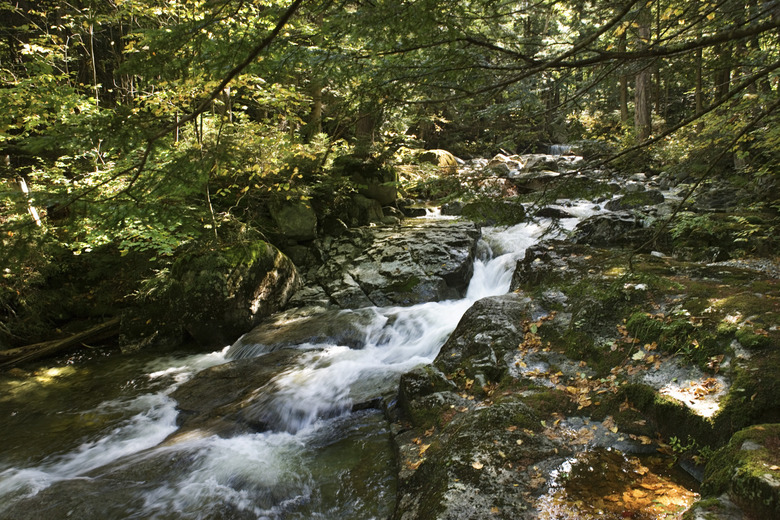Freshwater Streams & Ecosystem Components
Ecosystems are defined as all of the interactions and relationships between populations of organisms and their natural environment. This includes both biotic (living) and abiotic (non-living) factors.
Freshwater ecosystems are some of the rarest on Earth. Despite 71 percent of the Earth being covered with water, over 96 percent of that water is saltwater in the oceans.
Freshwater ecosystems can take the form of ponds, lakes, marshes, streams and more. Both biotic and abiotic factors in freshwater ecosystem environments create complex organismal relationships, nutrient cycles, energy flow and more.
And while factors in other freshwater environments might be similar to those in a stream, like biotic factors in a lake, for example, stream environments are unique and different from other freshwater habitats.
Stream Ecosystem Definition
Stream Ecosystem Definition
A stream is a general term as a small channel of freshwater that contains flowing water. They can be both natural and artificial. Many streams are "offshoots" of larger bodies of water like lakes or rivers. Natural streams are further classified as when they flow, where they flow from and if they're continuous.
Perennial streams flow all year long while seasonal streams are only seen at certain times of year, usually in wet season or as a result of snow or ice melting.
Continuous streams flow without stopping until they reach an endpoint or another body of water. Interrupted steams, on the other hand, may have breaks or different reaches depending on seasonality, barriers and other factors.
Abiotic Factors
Abiotic Factors
Abiotic factors are defined as nonliving things that affect and shape an ecosystem. In a freshwater ecosystem like a stream, the following are going to be some of the most important abiotic factors:
- Temperature
- Sunlight levels
- pH level of the water
- Vitamins and minerals in the water
- Precipitation levels
- Water clarity
- Water chemistry
Chemistry of the water including pH levels along with abiotic nutrients in the water (minerals, chemicals, gases, etc.) are some of the most important factors in a freshwater ecosystem like a stream. Organisms depend on these nutrients in order to live, which is what will keep the stream a balanced and healthy community.
If pH levels are changed, nutrients become imbalanced, pollutants/toxins enter, light levels decrease or if there are any other changes to these abiotic factors, the organisms that have adjusted to their stream environment will no longer be able to survive. This will cause a chain reaction of organismal death and further imbalance of the abiotic factors and the ecosystem overall.
Biotic Factors
Biotic Factors
Biotic factors are all of the living things and factors within an ecosystem. This includes things as tiny as microscopic bacteria found at the banks of the stream to the huge bears that hunt for fish in the stream's water.
According to the U.S. Geological Survey, there are three key and dominant biotic factors that make up a stream ecosystem: fish, invertebrate species and algae.
Biotic Factor: Algae
Biotic Factor: Algae
**Algae** is perhaps the most important biotic factor since these autotrophs are responsible for turning the sun's energy that penetrates the water's surface into usable chemical energy and biomass via photosynthesis.
Without this freshwater algae, there would be no way for energy to enter the ecosystem. Other primary producers can exist in these ecosystems as well including trees along the banks, water lilies, duckweed, cattails and more.
Invertebrate Species
Invertebrate Species
Invertebrate species that are important to freshwater ecosystems like streams generally include segmented worms, arthropods and mollusks. Some specific examples include the common earthworm, leeches, water beetles, mayflies, dragonflies, mussels and more.
Fish Species
Fish Species
Fish species are another critical biotic factor that make up stream communities. These fish will eat both the algae and the invertebrate species in the water. They'll also provide food for larger fish as well as other organisms in surrounding communities like bears and foxes.
Other animal species common in streams include crayfish, spiders, frogs, water snakes and bird species (ducks, kingfishers, etc). Other organisms like plankton and various species of protists are also biotic factors relevant in a stream ecosystem.
Cite This Article
MLA
Walsh, Elliot. "Freshwater Streams & Ecosystem Components" sciencing.com, https://www.sciencing.com/freshwater-streams-ecosystem-components-23165/. 20 June 2019.
APA
Walsh, Elliot. (2019, June 20). Freshwater Streams & Ecosystem Components. sciencing.com. Retrieved from https://www.sciencing.com/freshwater-streams-ecosystem-components-23165/
Chicago
Walsh, Elliot. Freshwater Streams & Ecosystem Components last modified August 30, 2022. https://www.sciencing.com/freshwater-streams-ecosystem-components-23165/
